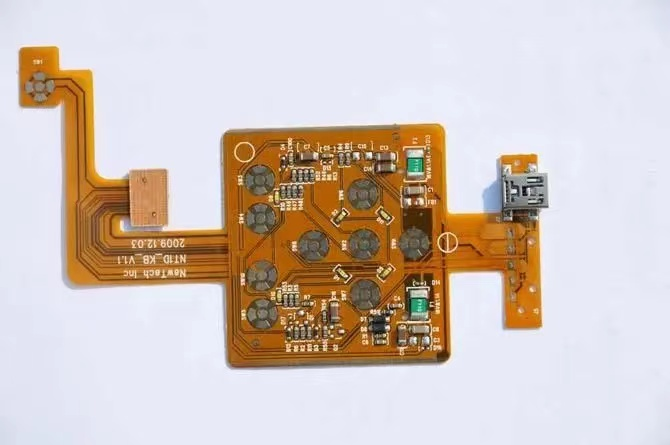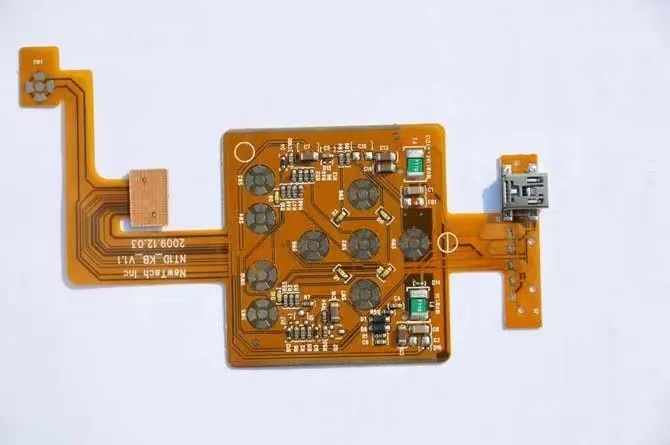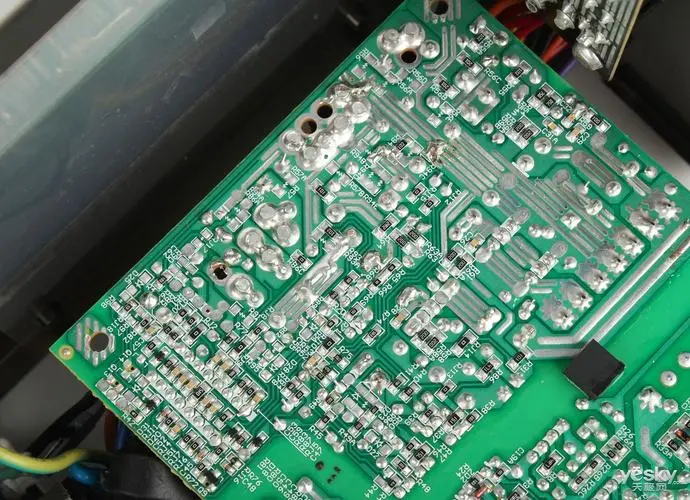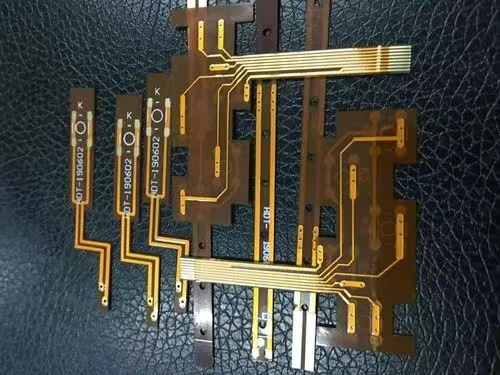
Multilayer FPC soft board
Multilayer FPC soft board, like rigid multilayer PCB, can be made into multilayer FPC soft board by using multilayer lamination technology. The simplest multi-layer FPC soft board is a three-layer soft PCB formed by covering two copper shielding layers on both sides of a single sided PCB. The three-layer flexible PCB is equivalent to coaxial wire or shielded wire in electrical characteristics. The most commonly used multi-layer FPC soft board structure is a four layer structure, which uses metallized holes to realize inter layer interconnection. The middle two layers are generally the power layer and the grounding layer.
The advantage of multilayer FPC soft board is that the substrate film has light weight and excellent electrical properties, such as low dielectric constant. The multilayer FPC soft board made of polyimide film is about 1/3 lighter than the rigid epoxy glass cloth multilayer PCB board, but it loses the excellent flexibility of single-sided and double-sided FPC soft boards. Most of these products do not require flexibility. Today, FPC manufacturers will show you the classification of multi-layer soft boards:
Multilayer FPC soft boards can be further divided into the following types:
1) Multilayer FPC soft board is formed on flexible insulating substrate, and its finished product is specified as flexible: this structure usually bonds the two ends of many single or double sided microstrip flexible PCBs together, but its center parts are not bonded together, so that it is highly flexible. In order to have the desired electrical characteristics, such as matching the characteristic impedance performance with the rigid PCB it interconnects, each circuit layer of the multi-layer FPC soft board component must be designed with a signal line on the ground plane. In order to have high flexibility, a thin and suitable coating, such as polyimide, can be used on the conductor layer to replace a thick laminated coating. The metallized holes enable the z-plane between the flexible circuit layers to achieve the required interconnection. This multilayer FPC soft board is most suitable for design requiring flexibility, high reliability and high density.

2) Multilayer PCB is formed on soft insulating substrate, and the finished product can be flexed as specified: this kind of multilayer FPC soft board is made of soft insulating materials, such as polyimide film, laminated into multilayer boards. Loss of inherent flexibility after lamination. This kind of FPC soft board is used when the design requires the maximum use of the insulation characteristics of the film, such as low dielectric constant, uniform thickness medium, light weight and continuous processing. For example, multilayer PCBs made of polyimide film insulation materials are about one-third lighter than epoxy glass cloth rigid PCBs.
3) Multilayer PCB is formed on soft insulating substrate, and the finished product must be able to be formed, rather than continuously flexed: this kind of multilayer FPC soft board is made of soft insulating materials. Although it is made of soft materials, due to the limitation of electrical design, for example, for the required conductor resistance, thick conductors are required, or for the required impedance or capacitance, thick insulation isolation is required between the signal layer and the ground plane. Therefore, it has been formed in the finished product application. The term "formable" is defined as: multilayer FPC soft board components have the ability to make the required shape, and can no longer be flexed in application. It is applied in the internal wiring of avionics unit. At this time, it is required that the stripline or three-dimensional space designed conductor has low resistance, minimal capacitive coupling or circuit noise, and can be smoothly bent to 90 ° at the interconnection end. Multilayer FPC soft board made of polyimide film material realizes this wiring task. Because polyimide film has high temperature resistance, flexibility, and good overall electrical and mechanical properties. In order to realize all interconnections of this component section, the routing part can be further divided into multiple multi-layer flexible circuit components, which are combined with adhesive tape to form a printed circuit board.
FPC multilayer soft and hard combination circuit board (soft and hard combination board)
This type is usually on one or two rigid PCBs, which contain FPC soft boards that are necessary to form a whole. The FPC soft board layer is laminated in a rigid multilayer PCB to meet special electrical requirements or extend to the outside of the rigid circuit, so as to replace the Z-plane circuit assembly capability. Such products have been widely used in electronic equipment that take compressing weight and volume as the key, and ensure high reliability, high-density assembly and excellent electrical characteristics.
The FPC multi-layer soft and hard bonding plate can also bond and press the ends of many single-sided or double-sided FPC soft plates together to form a rigid part, while the middle is not bonded to form a soft part. The Z side of the rigid part is interconnected with metallized holes. Flexible circuits can be laminated into rigid multilayer boards. This kind of PCB is increasingly used in those occasions that require ultra-high package density, excellent electrical characteristics, high reliability and strict volume limitation.
A series of hybrid multilayer FPC soft board components have been designed for military avionics. In these applications, weight and volume are crucial. In order to meet the specified weight and volume limits, the internal package density must be very high. In addition to high circuit density, all signal transmission lines must be shielded to minimize crosstalk and noise. If shielded separated conductors are to be used, it is practically impossible to package them into the system economically. In this way, a mixed multilayer FPC soft board is used to realize its interconnection. This component contains the shielded signal lines in the flat stripline FPC soft board, which is an essential part of the rigid PCB. At a relatively high level of operation, after the manufacturing is completed, the PCB forms a 90 ° S-shaped bend, which provides a way for z plane interconnection. Under the effect of the vibration stress of x, y and z planes, the stress strain can be eliminated on the solder joint.







